Operations Management Report: Tesco's Strategies and Analysis
VerifiedAdded on 2023/01/03
|11
|2758
|28
Report
AI Summary
This report provides a comprehensive analysis of operations management, focusing on the multinational grocery company Tesco. It delves into key aspects such as supply chain management, examining issues like globalization, fast-changing markets, and quality compliance, and proposes improvement strategies like managing costs and risks. The report then explores capacity management, discussing storage capacity, policy implementation, and the application of the theory of constraints, along with suggestions for improvement. Inventory management is also examined, addressing issues such as lack of inventory knowledge, inefficient processes, and customer demand, along with strategies like managing relationships and contingency planning. Finally, the report investigates quality management methods employed by Tesco, including customer-focused strategies, leadership, employee engagement, process methods, and continuous improvement, while also highlighting the issues of insufficient motivation, lack of quality equipment, and inadequate training. The report aims to provide a detailed overview of Tesco's operational strategies and challenges.
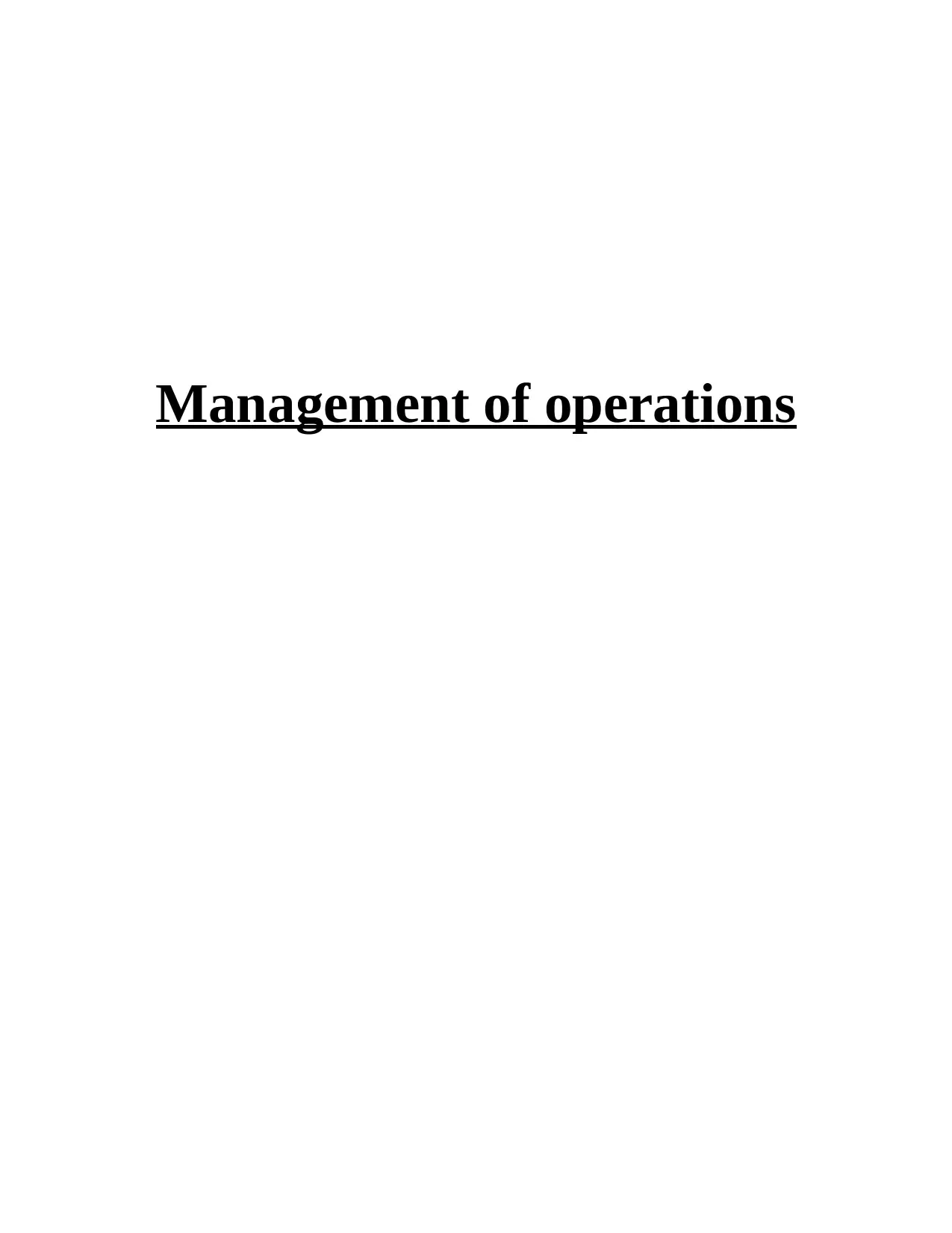
Management of operations
Paraphrase This Document
Need a fresh take? Get an instant paraphrase of this document with our AI Paraphraser
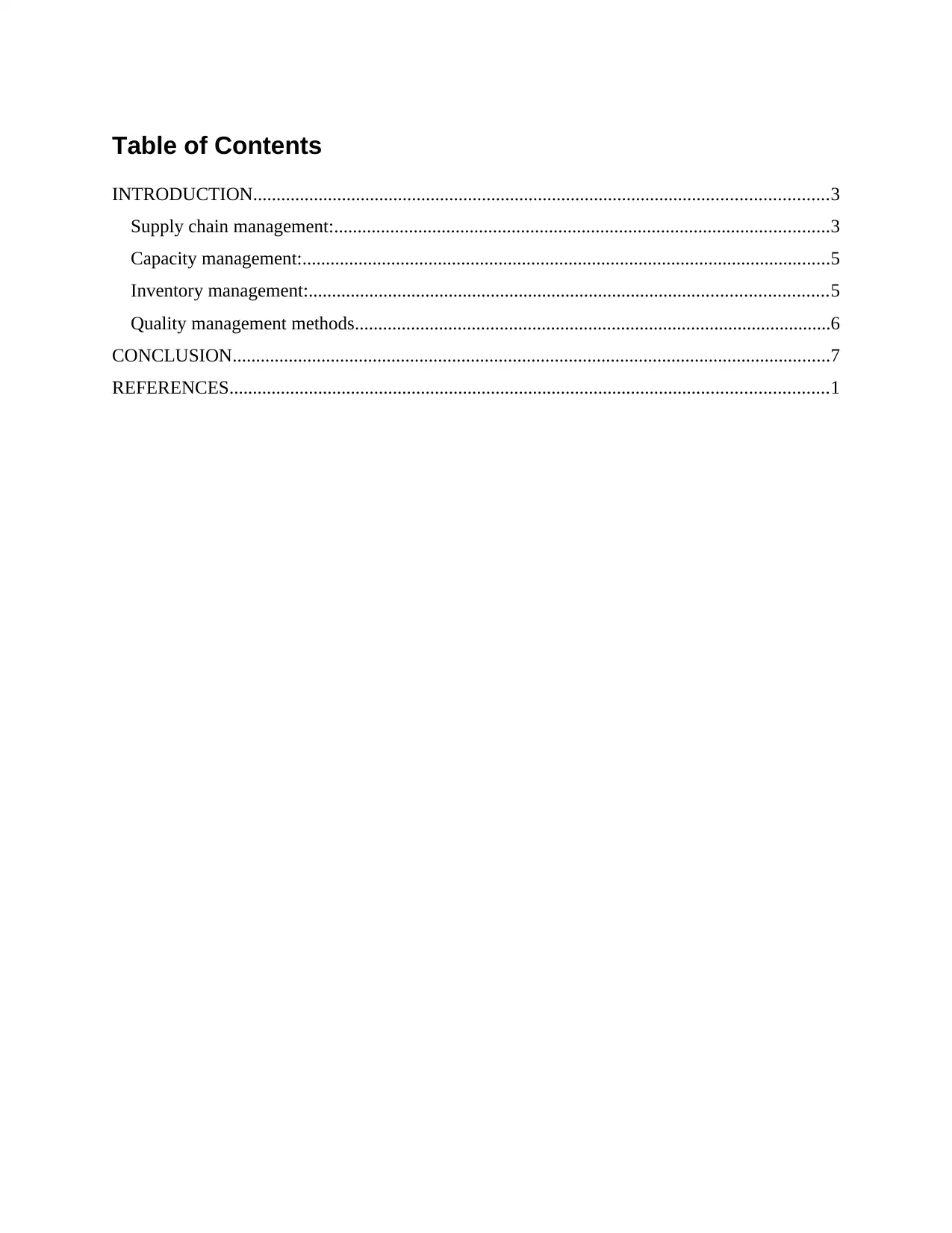
Table of Contents
INTRODUCTION...........................................................................................................................3
Supply chain management:..........................................................................................................3
Capacity management:.................................................................................................................5
Inventory management:...............................................................................................................5
Quality management methods......................................................................................................6
CONCLUSION................................................................................................................................7
REFERENCES................................................................................................................................1
INTRODUCTION...........................................................................................................................3
Supply chain management:..........................................................................................................3
Capacity management:.................................................................................................................5
Inventory management:...............................................................................................................5
Quality management methods......................................................................................................6
CONCLUSION................................................................................................................................7
REFERENCES................................................................................................................................1
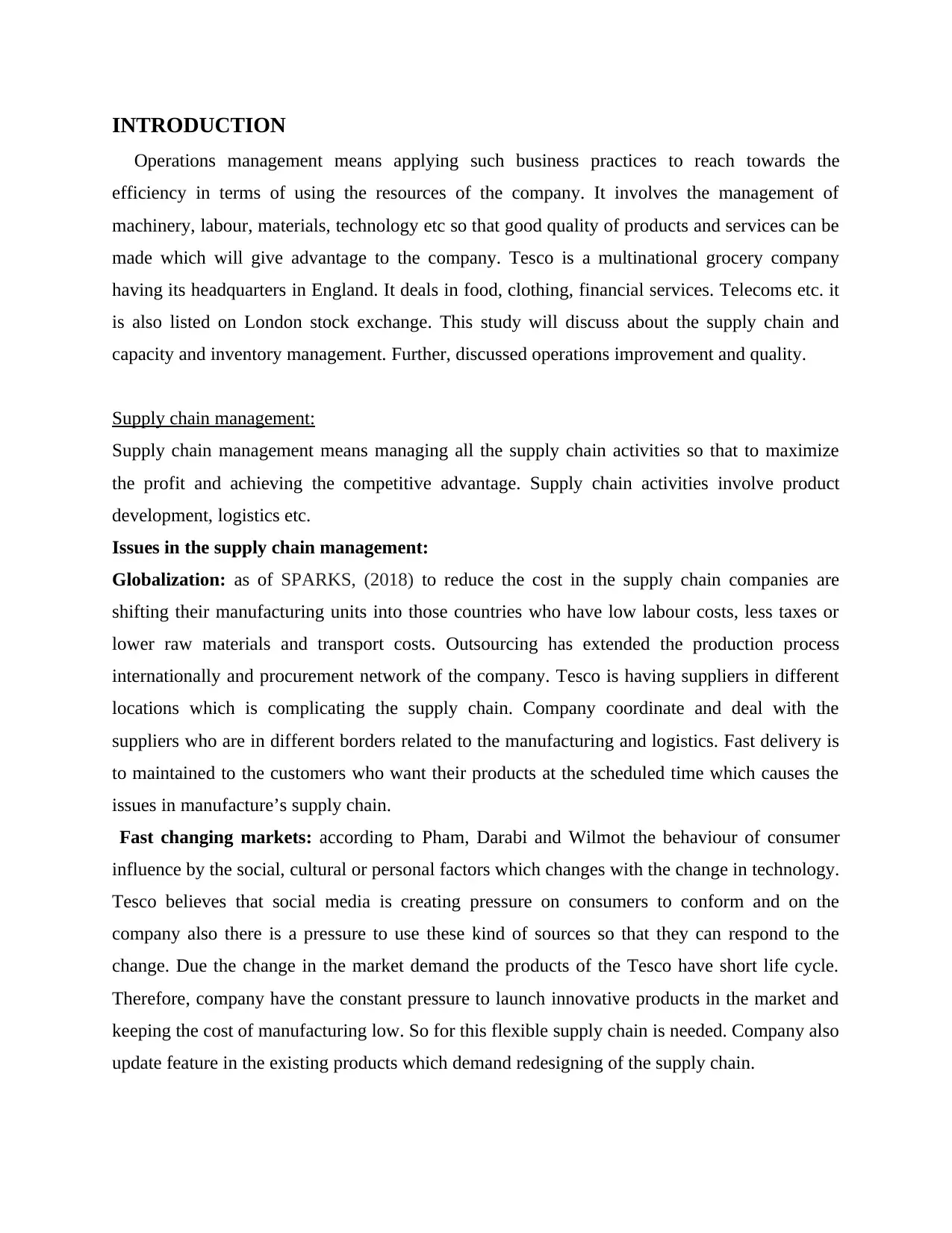
INTRODUCTION
Operations management means applying such business practices to reach towards the
efficiency in terms of using the resources of the company. It involves the management of
machinery, labour, materials, technology etc so that good quality of products and services can be
made which will give advantage to the company. Tesco is a multinational grocery company
having its headquarters in England. It deals in food, clothing, financial services. Telecoms etc. it
is also listed on London stock exchange. This study will discuss about the supply chain and
capacity and inventory management. Further, discussed operations improvement and quality.
Supply chain management:
Supply chain management means managing all the supply chain activities so that to maximize
the profit and achieving the competitive advantage. Supply chain activities involve product
development, logistics etc.
Issues in the supply chain management:
Globalization: as of SPARKS, (2018) to reduce the cost in the supply chain companies are
shifting their manufacturing units into those countries who have low labour costs, less taxes or
lower raw materials and transport costs. Outsourcing has extended the production process
internationally and procurement network of the company. Tesco is having suppliers in different
locations which is complicating the supply chain. Company coordinate and deal with the
suppliers who are in different borders related to the manufacturing and logistics. Fast delivery is
to maintained to the customers who want their products at the scheduled time which causes the
issues in manufacture’s supply chain.
Fast changing markets: according to Pham, Darabi and Wilmot the behaviour of consumer
influence by the social, cultural or personal factors which changes with the change in technology.
Tesco believes that social media is creating pressure on consumers to conform and on the
company also there is a pressure to use these kind of sources so that they can respond to the
change. Due the change in the market demand the products of the Tesco have short life cycle.
Therefore, company have the constant pressure to launch innovative products in the market and
keeping the cost of manufacturing low. So for this flexible supply chain is needed. Company also
update feature in the existing products which demand redesigning of the supply chain.
Operations management means applying such business practices to reach towards the
efficiency in terms of using the resources of the company. It involves the management of
machinery, labour, materials, technology etc so that good quality of products and services can be
made which will give advantage to the company. Tesco is a multinational grocery company
having its headquarters in England. It deals in food, clothing, financial services. Telecoms etc. it
is also listed on London stock exchange. This study will discuss about the supply chain and
capacity and inventory management. Further, discussed operations improvement and quality.
Supply chain management:
Supply chain management means managing all the supply chain activities so that to maximize
the profit and achieving the competitive advantage. Supply chain activities involve product
development, logistics etc.
Issues in the supply chain management:
Globalization: as of SPARKS, (2018) to reduce the cost in the supply chain companies are
shifting their manufacturing units into those countries who have low labour costs, less taxes or
lower raw materials and transport costs. Outsourcing has extended the production process
internationally and procurement network of the company. Tesco is having suppliers in different
locations which is complicating the supply chain. Company coordinate and deal with the
suppliers who are in different borders related to the manufacturing and logistics. Fast delivery is
to maintained to the customers who want their products at the scheduled time which causes the
issues in manufacture’s supply chain.
Fast changing markets: according to Pham, Darabi and Wilmot the behaviour of consumer
influence by the social, cultural or personal factors which changes with the change in technology.
Tesco believes that social media is creating pressure on consumers to conform and on the
company also there is a pressure to use these kind of sources so that they can respond to the
change. Due the change in the market demand the products of the Tesco have short life cycle.
Therefore, company have the constant pressure to launch innovative products in the market and
keeping the cost of manufacturing low. So for this flexible supply chain is needed. Company also
update feature in the existing products which demand redesigning of the supply chain.
⊘ This is a preview!⊘
Do you want full access?
Subscribe today to unlock all pages.

Trusted by 1+ million students worldwide
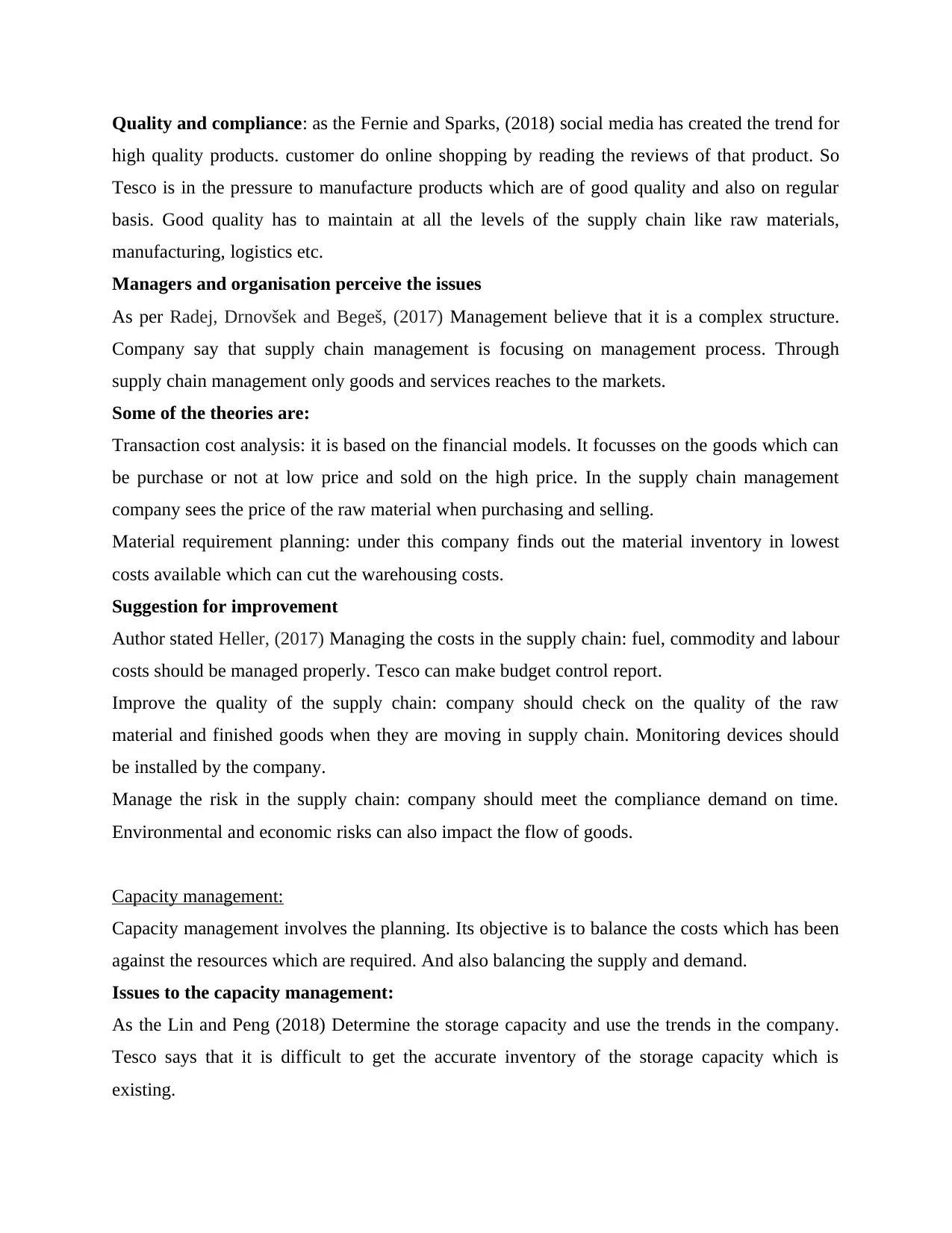
Quality and compliance: as the Fernie and Sparks, (2018) social media has created the trend for
high quality products. customer do online shopping by reading the reviews of that product. So
Tesco is in the pressure to manufacture products which are of good quality and also on regular
basis. Good quality has to maintain at all the levels of the supply chain like raw materials,
manufacturing, logistics etc.
Managers and organisation perceive the issues
As per Radej, Drnovšek and Begeš, (2017) Management believe that it is a complex structure.
Company say that supply chain management is focusing on management process. Through
supply chain management only goods and services reaches to the markets.
Some of the theories are:
Transaction cost analysis: it is based on the financial models. It focusses on the goods which can
be purchase or not at low price and sold on the high price. In the supply chain management
company sees the price of the raw material when purchasing and selling.
Material requirement planning: under this company finds out the material inventory in lowest
costs available which can cut the warehousing costs.
Suggestion for improvement
Author stated Heller, (2017) Managing the costs in the supply chain: fuel, commodity and labour
costs should be managed properly. Tesco can make budget control report.
Improve the quality of the supply chain: company should check on the quality of the raw
material and finished goods when they are moving in supply chain. Monitoring devices should
be installed by the company.
Manage the risk in the supply chain: company should meet the compliance demand on time.
Environmental and economic risks can also impact the flow of goods.
Capacity management:
Capacity management involves the planning. Its objective is to balance the costs which has been
against the resources which are required. And also balancing the supply and demand.
Issues to the capacity management:
As the Lin and Peng (2018) Determine the storage capacity and use the trends in the company.
Tesco says that it is difficult to get the accurate inventory of the storage capacity which is
existing.
high quality products. customer do online shopping by reading the reviews of that product. So
Tesco is in the pressure to manufacture products which are of good quality and also on regular
basis. Good quality has to maintain at all the levels of the supply chain like raw materials,
manufacturing, logistics etc.
Managers and organisation perceive the issues
As per Radej, Drnovšek and Begeš, (2017) Management believe that it is a complex structure.
Company say that supply chain management is focusing on management process. Through
supply chain management only goods and services reaches to the markets.
Some of the theories are:
Transaction cost analysis: it is based on the financial models. It focusses on the goods which can
be purchase or not at low price and sold on the high price. In the supply chain management
company sees the price of the raw material when purchasing and selling.
Material requirement planning: under this company finds out the material inventory in lowest
costs available which can cut the warehousing costs.
Suggestion for improvement
Author stated Heller, (2017) Managing the costs in the supply chain: fuel, commodity and labour
costs should be managed properly. Tesco can make budget control report.
Improve the quality of the supply chain: company should check on the quality of the raw
material and finished goods when they are moving in supply chain. Monitoring devices should
be installed by the company.
Manage the risk in the supply chain: company should meet the compliance demand on time.
Environmental and economic risks can also impact the flow of goods.
Capacity management:
Capacity management involves the planning. Its objective is to balance the costs which has been
against the resources which are required. And also balancing the supply and demand.
Issues to the capacity management:
As the Lin and Peng (2018) Determine the storage capacity and use the trends in the company.
Tesco says that it is difficult to get the accurate inventory of the storage capacity which is
existing.
Paraphrase This Document
Need a fresh take? Get an instant paraphrase of this document with our AI Paraphraser
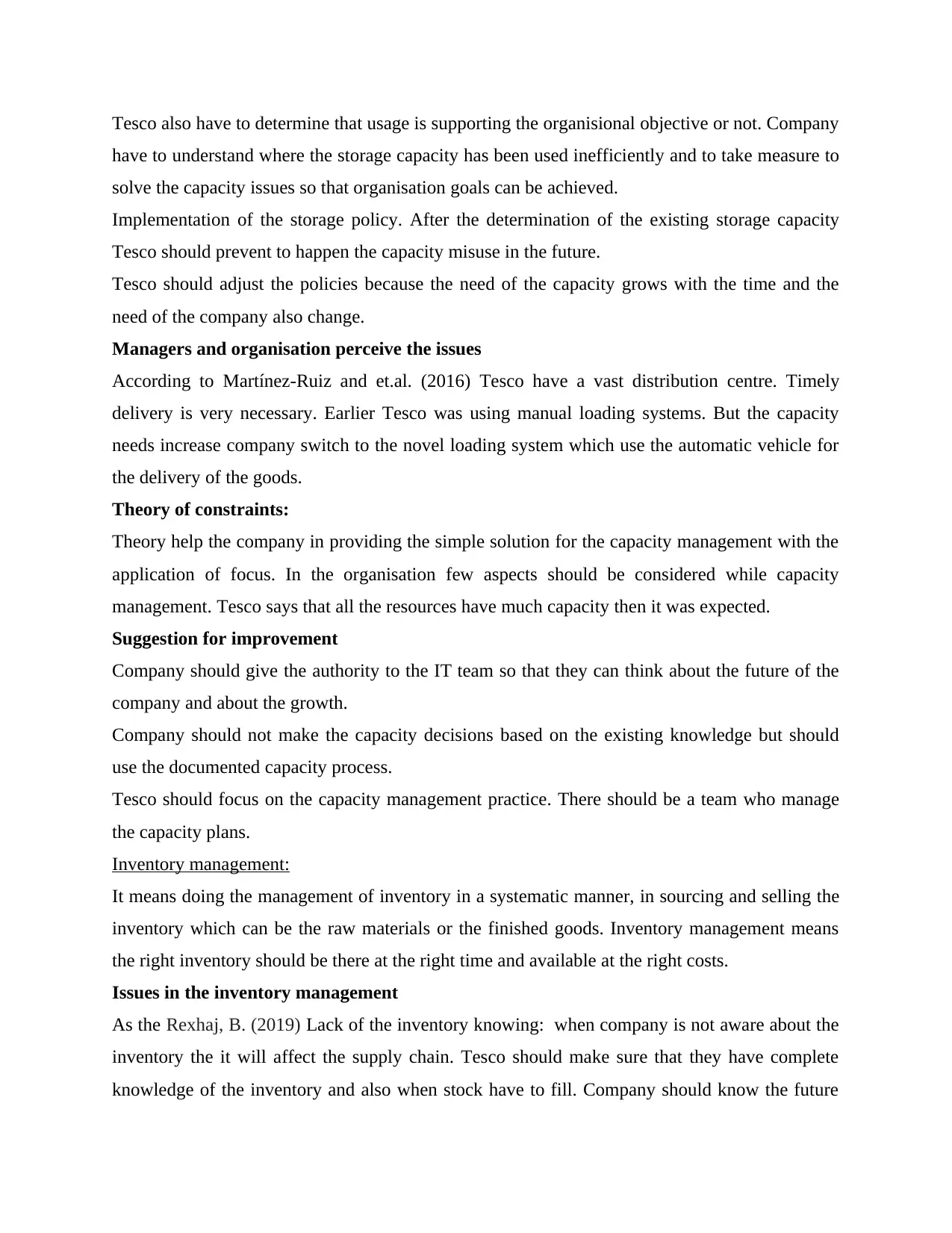
Tesco also have to determine that usage is supporting the organisional objective or not. Company
have to understand where the storage capacity has been used inefficiently and to take measure to
solve the capacity issues so that organisation goals can be achieved.
Implementation of the storage policy. After the determination of the existing storage capacity
Tesco should prevent to happen the capacity misuse in the future.
Tesco should adjust the policies because the need of the capacity grows with the time and the
need of the company also change.
Managers and organisation perceive the issues
According to Martínez-Ruiz and et.al. (2016) Tesco have a vast distribution centre. Timely
delivery is very necessary. Earlier Tesco was using manual loading systems. But the capacity
needs increase company switch to the novel loading system which use the automatic vehicle for
the delivery of the goods.
Theory of constraints:
Theory help the company in providing the simple solution for the capacity management with the
application of focus. In the organisation few aspects should be considered while capacity
management. Tesco says that all the resources have much capacity then it was expected.
Suggestion for improvement
Company should give the authority to the IT team so that they can think about the future of the
company and about the growth.
Company should not make the capacity decisions based on the existing knowledge but should
use the documented capacity process.
Tesco should focus on the capacity management practice. There should be a team who manage
the capacity plans.
Inventory management:
It means doing the management of inventory in a systematic manner, in sourcing and selling the
inventory which can be the raw materials or the finished goods. Inventory management means
the right inventory should be there at the right time and available at the right costs.
Issues in the inventory management
As the Rexhaj, B. (2019) Lack of the inventory knowing: when company is not aware about the
inventory the it will affect the supply chain. Tesco should make sure that they have complete
knowledge of the inventory and also when stock have to fill. Company should know the future
have to understand where the storage capacity has been used inefficiently and to take measure to
solve the capacity issues so that organisation goals can be achieved.
Implementation of the storage policy. After the determination of the existing storage capacity
Tesco should prevent to happen the capacity misuse in the future.
Tesco should adjust the policies because the need of the capacity grows with the time and the
need of the company also change.
Managers and organisation perceive the issues
According to Martínez-Ruiz and et.al. (2016) Tesco have a vast distribution centre. Timely
delivery is very necessary. Earlier Tesco was using manual loading systems. But the capacity
needs increase company switch to the novel loading system which use the automatic vehicle for
the delivery of the goods.
Theory of constraints:
Theory help the company in providing the simple solution for the capacity management with the
application of focus. In the organisation few aspects should be considered while capacity
management. Tesco says that all the resources have much capacity then it was expected.
Suggestion for improvement
Company should give the authority to the IT team so that they can think about the future of the
company and about the growth.
Company should not make the capacity decisions based on the existing knowledge but should
use the documented capacity process.
Tesco should focus on the capacity management practice. There should be a team who manage
the capacity plans.
Inventory management:
It means doing the management of inventory in a systematic manner, in sourcing and selling the
inventory which can be the raw materials or the finished goods. Inventory management means
the right inventory should be there at the right time and available at the right costs.
Issues in the inventory management
As the Rexhaj, B. (2019) Lack of the inventory knowing: when company is not aware about the
inventory the it will affect the supply chain. Tesco should make sure that they have complete
knowledge of the inventory and also when stock have to fill. Company should know the future
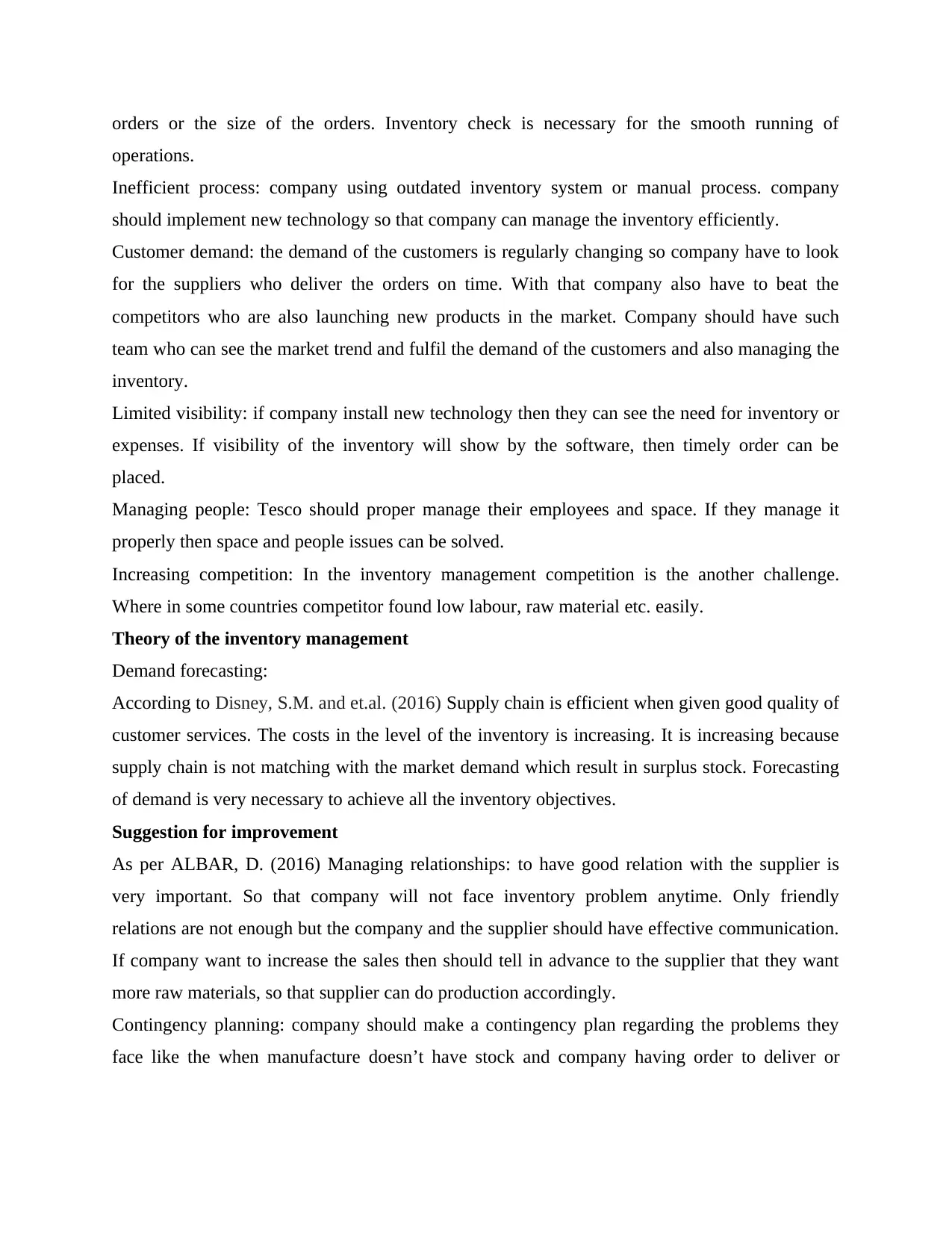
orders or the size of the orders. Inventory check is necessary for the smooth running of
operations.
Inefficient process: company using outdated inventory system or manual process. company
should implement new technology so that company can manage the inventory efficiently.
Customer demand: the demand of the customers is regularly changing so company have to look
for the suppliers who deliver the orders on time. With that company also have to beat the
competitors who are also launching new products in the market. Company should have such
team who can see the market trend and fulfil the demand of the customers and also managing the
inventory.
Limited visibility: if company install new technology then they can see the need for inventory or
expenses. If visibility of the inventory will show by the software, then timely order can be
placed.
Managing people: Tesco should proper manage their employees and space. If they manage it
properly then space and people issues can be solved.
Increasing competition: In the inventory management competition is the another challenge.
Where in some countries competitor found low labour, raw material etc. easily.
Theory of the inventory management
Demand forecasting:
According to Disney, S.M. and et.al. (2016) Supply chain is efficient when given good quality of
customer services. The costs in the level of the inventory is increasing. It is increasing because
supply chain is not matching with the market demand which result in surplus stock. Forecasting
of demand is very necessary to achieve all the inventory objectives.
Suggestion for improvement
As per ALBAR, D. (2016) Managing relationships: to have good relation with the supplier is
very important. So that company will not face inventory problem anytime. Only friendly
relations are not enough but the company and the supplier should have effective communication.
If company want to increase the sales then should tell in advance to the supplier that they want
more raw materials, so that supplier can do production accordingly.
Contingency planning: company should make a contingency plan regarding the problems they
face like the when manufacture doesn’t have stock and company having order to deliver or
operations.
Inefficient process: company using outdated inventory system or manual process. company
should implement new technology so that company can manage the inventory efficiently.
Customer demand: the demand of the customers is regularly changing so company have to look
for the suppliers who deliver the orders on time. With that company also have to beat the
competitors who are also launching new products in the market. Company should have such
team who can see the market trend and fulfil the demand of the customers and also managing the
inventory.
Limited visibility: if company install new technology then they can see the need for inventory or
expenses. If visibility of the inventory will show by the software, then timely order can be
placed.
Managing people: Tesco should proper manage their employees and space. If they manage it
properly then space and people issues can be solved.
Increasing competition: In the inventory management competition is the another challenge.
Where in some countries competitor found low labour, raw material etc. easily.
Theory of the inventory management
Demand forecasting:
According to Disney, S.M. and et.al. (2016) Supply chain is efficient when given good quality of
customer services. The costs in the level of the inventory is increasing. It is increasing because
supply chain is not matching with the market demand which result in surplus stock. Forecasting
of demand is very necessary to achieve all the inventory objectives.
Suggestion for improvement
As per ALBAR, D. (2016) Managing relationships: to have good relation with the supplier is
very important. So that company will not face inventory problem anytime. Only friendly
relations are not enough but the company and the supplier should have effective communication.
If company want to increase the sales then should tell in advance to the supplier that they want
more raw materials, so that supplier can do production accordingly.
Contingency planning: company should make a contingency plan regarding the problems they
face like the when manufacture doesn’t have stock and company having order to deliver or
⊘ This is a preview!⊘
Do you want full access?
Subscribe today to unlock all pages.

Trusted by 1+ million students worldwide
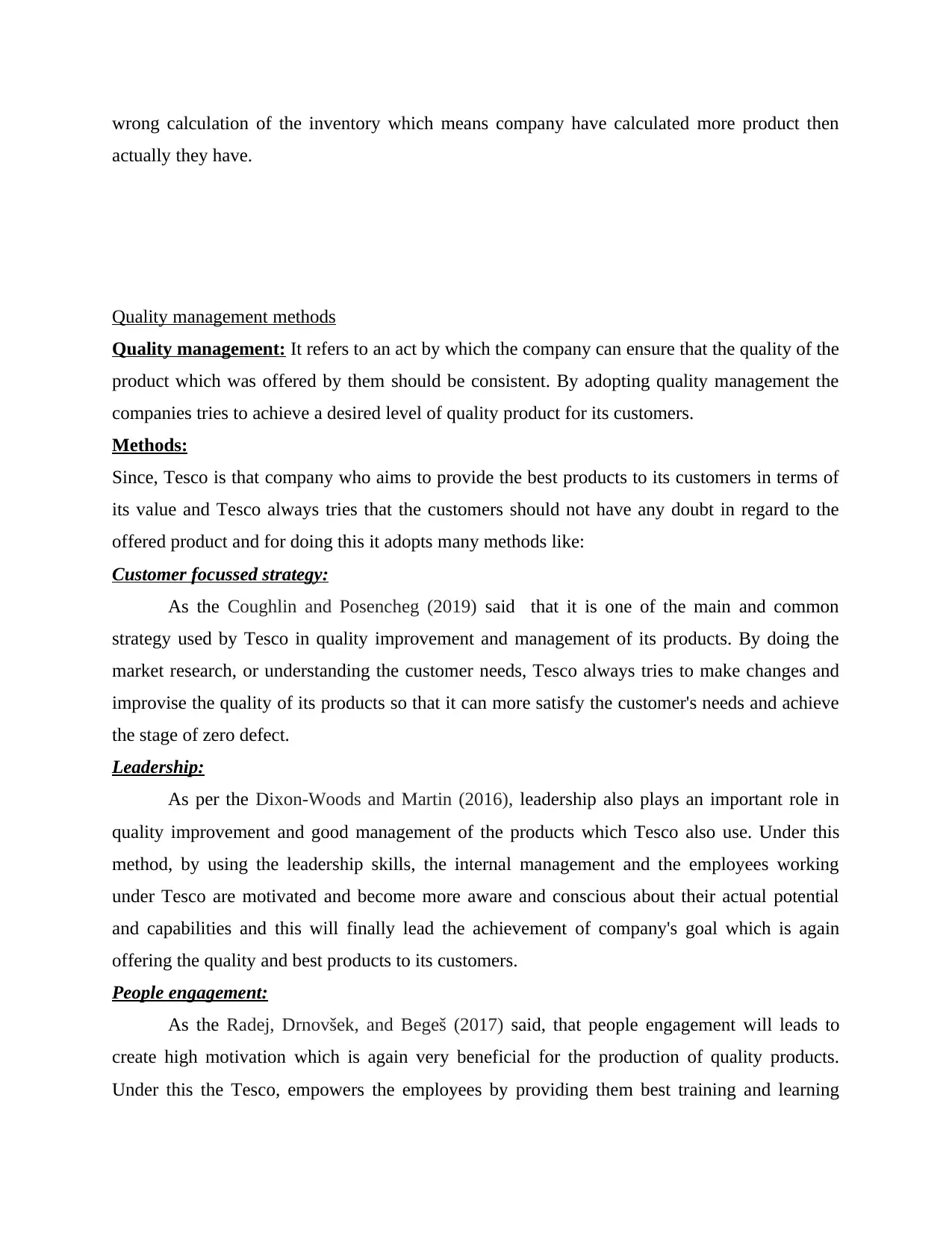
wrong calculation of the inventory which means company have calculated more product then
actually they have.
Quality management methods
Quality management: It refers to an act by which the company can ensure that the quality of the
product which was offered by them should be consistent. By adopting quality management the
companies tries to achieve a desired level of quality product for its customers.
Methods:
Since, Tesco is that company who aims to provide the best products to its customers in terms of
its value and Tesco always tries that the customers should not have any doubt in regard to the
offered product and for doing this it adopts many methods like:
Customer focussed strategy:
As the Coughlin and Posencheg (2019) said that it is one of the main and common
strategy used by Tesco in quality improvement and management of its products. By doing the
market research, or understanding the customer needs, Tesco always tries to make changes and
improvise the quality of its products so that it can more satisfy the customer's needs and achieve
the stage of zero defect.
Leadership:
As per the Dixon-Woods and Martin (2016), leadership also plays an important role in
quality improvement and good management of the products which Tesco also use. Under this
method, by using the leadership skills, the internal management and the employees working
under Tesco are motivated and become more aware and conscious about their actual potential
and capabilities and this will finally lead the achievement of company's goal which is again
offering the quality and best products to its customers.
People engagement:
As the Radej, Drnovšek, and Begeš (2017) said, that people engagement will leads to
create high motivation which is again very beneficial for the production of quality products.
Under this the Tesco, empowers the employees by providing them best training and learning
actually they have.
Quality management methods
Quality management: It refers to an act by which the company can ensure that the quality of the
product which was offered by them should be consistent. By adopting quality management the
companies tries to achieve a desired level of quality product for its customers.
Methods:
Since, Tesco is that company who aims to provide the best products to its customers in terms of
its value and Tesco always tries that the customers should not have any doubt in regard to the
offered product and for doing this it adopts many methods like:
Customer focussed strategy:
As the Coughlin and Posencheg (2019) said that it is one of the main and common
strategy used by Tesco in quality improvement and management of its products. By doing the
market research, or understanding the customer needs, Tesco always tries to make changes and
improvise the quality of its products so that it can more satisfy the customer's needs and achieve
the stage of zero defect.
Leadership:
As per the Dixon-Woods and Martin (2016), leadership also plays an important role in
quality improvement and good management of the products which Tesco also use. Under this
method, by using the leadership skills, the internal management and the employees working
under Tesco are motivated and become more aware and conscious about their actual potential
and capabilities and this will finally lead the achievement of company's goal which is again
offering the quality and best products to its customers.
People engagement:
As the Radej, Drnovšek, and Begeš (2017) said, that people engagement will leads to
create high motivation which is again very beneficial for the production of quality products.
Under this the Tesco, empowers the employees by providing them best training and learning
Paraphrase This Document
Need a fresh take? Get an instant paraphrase of this document with our AI Paraphraser
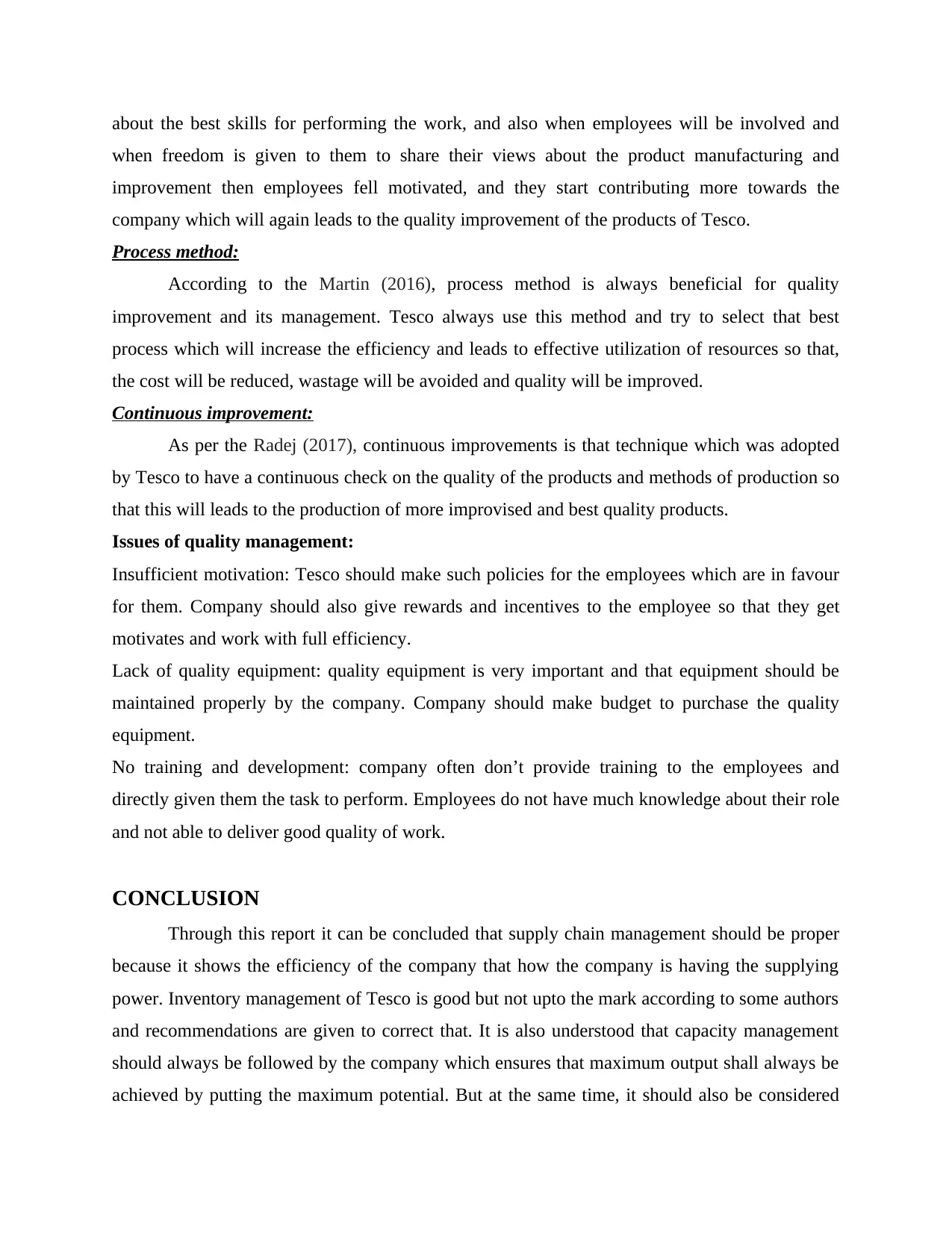
about the best skills for performing the work, and also when employees will be involved and
when freedom is given to them to share their views about the product manufacturing and
improvement then employees fell motivated, and they start contributing more towards the
company which will again leads to the quality improvement of the products of Tesco.
Process method:
According to the Martin (2016), process method is always beneficial for quality
improvement and its management. Tesco always use this method and try to select that best
process which will increase the efficiency and leads to effective utilization of resources so that,
the cost will be reduced, wastage will be avoided and quality will be improved.
Continuous improvement:
As per the Radej (2017), continuous improvements is that technique which was adopted
by Tesco to have a continuous check on the quality of the products and methods of production so
that this will leads to the production of more improvised and best quality products.
Issues of quality management:
Insufficient motivation: Tesco should make such policies for the employees which are in favour
for them. Company should also give rewards and incentives to the employee so that they get
motivates and work with full efficiency.
Lack of quality equipment: quality equipment is very important and that equipment should be
maintained properly by the company. Company should make budget to purchase the quality
equipment.
No training and development: company often don’t provide training to the employees and
directly given them the task to perform. Employees do not have much knowledge about their role
and not able to deliver good quality of work.
CONCLUSION
Through this report it can be concluded that supply chain management should be proper
because it shows the efficiency of the company that how the company is having the supplying
power. Inventory management of Tesco is good but not upto the mark according to some authors
and recommendations are given to correct that. It is also understood that capacity management
should always be followed by the company which ensures that maximum output shall always be
achieved by putting the maximum potential. But at the same time, it should also be considered
when freedom is given to them to share their views about the product manufacturing and
improvement then employees fell motivated, and they start contributing more towards the
company which will again leads to the quality improvement of the products of Tesco.
Process method:
According to the Martin (2016), process method is always beneficial for quality
improvement and its management. Tesco always use this method and try to select that best
process which will increase the efficiency and leads to effective utilization of resources so that,
the cost will be reduced, wastage will be avoided and quality will be improved.
Continuous improvement:
As per the Radej (2017), continuous improvements is that technique which was adopted
by Tesco to have a continuous check on the quality of the products and methods of production so
that this will leads to the production of more improvised and best quality products.
Issues of quality management:
Insufficient motivation: Tesco should make such policies for the employees which are in favour
for them. Company should also give rewards and incentives to the employee so that they get
motivates and work with full efficiency.
Lack of quality equipment: quality equipment is very important and that equipment should be
maintained properly by the company. Company should make budget to purchase the quality
equipment.
No training and development: company often don’t provide training to the employees and
directly given them the task to perform. Employees do not have much knowledge about their role
and not able to deliver good quality of work.
CONCLUSION
Through this report it can be concluded that supply chain management should be proper
because it shows the efficiency of the company that how the company is having the supplying
power. Inventory management of Tesco is good but not upto the mark according to some authors
and recommendations are given to correct that. It is also understood that capacity management
should always be followed by the company which ensures that maximum output shall always be
achieved by putting the maximum potential. But at the same time, it should also be considered
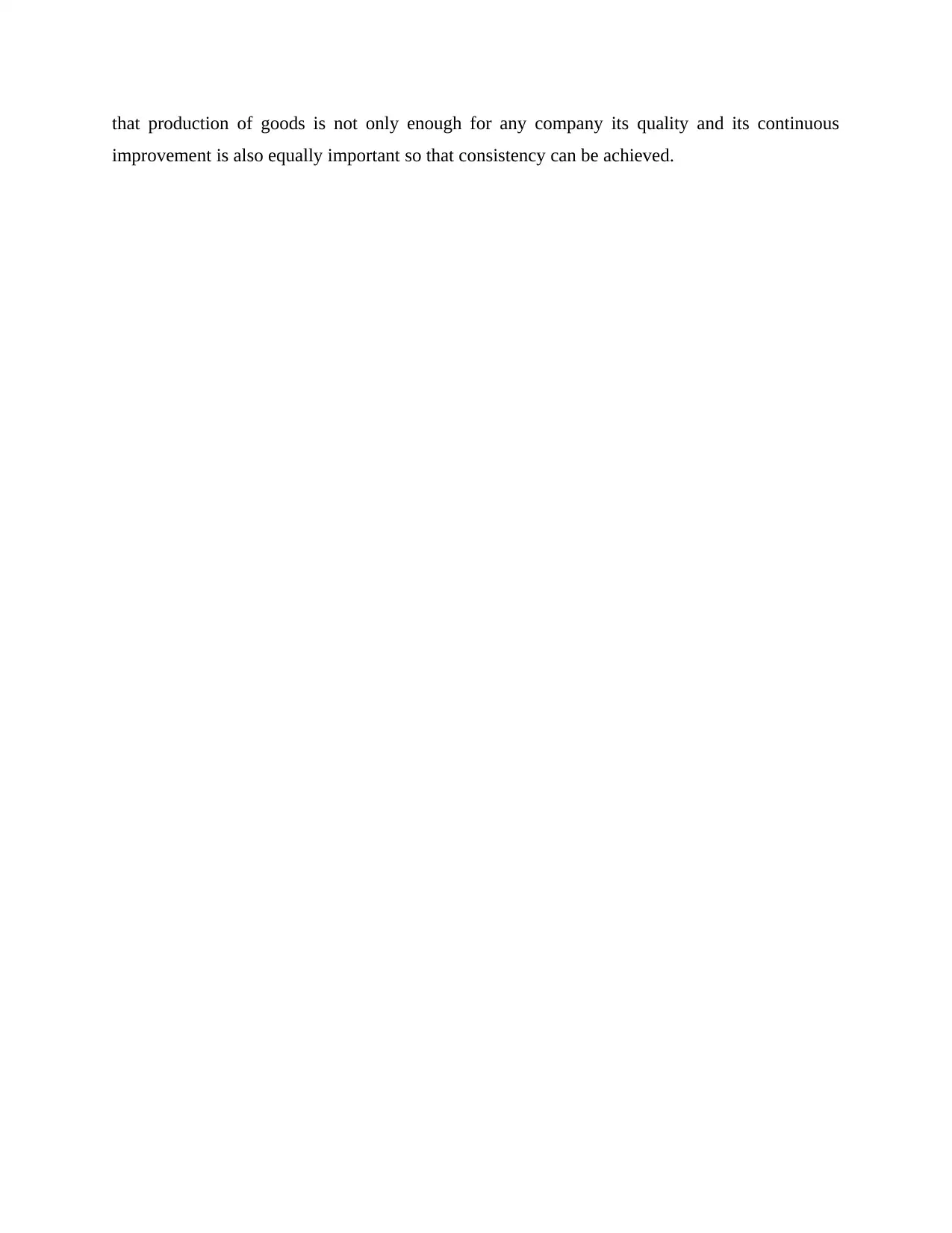
that production of goods is not only enough for any company its quality and its continuous
improvement is also equally important so that consistency can be achieved.
improvement is also equally important so that consistency can be achieved.
⊘ This is a preview!⊘
Do you want full access?
Subscribe today to unlock all pages.

Trusted by 1+ million students worldwide
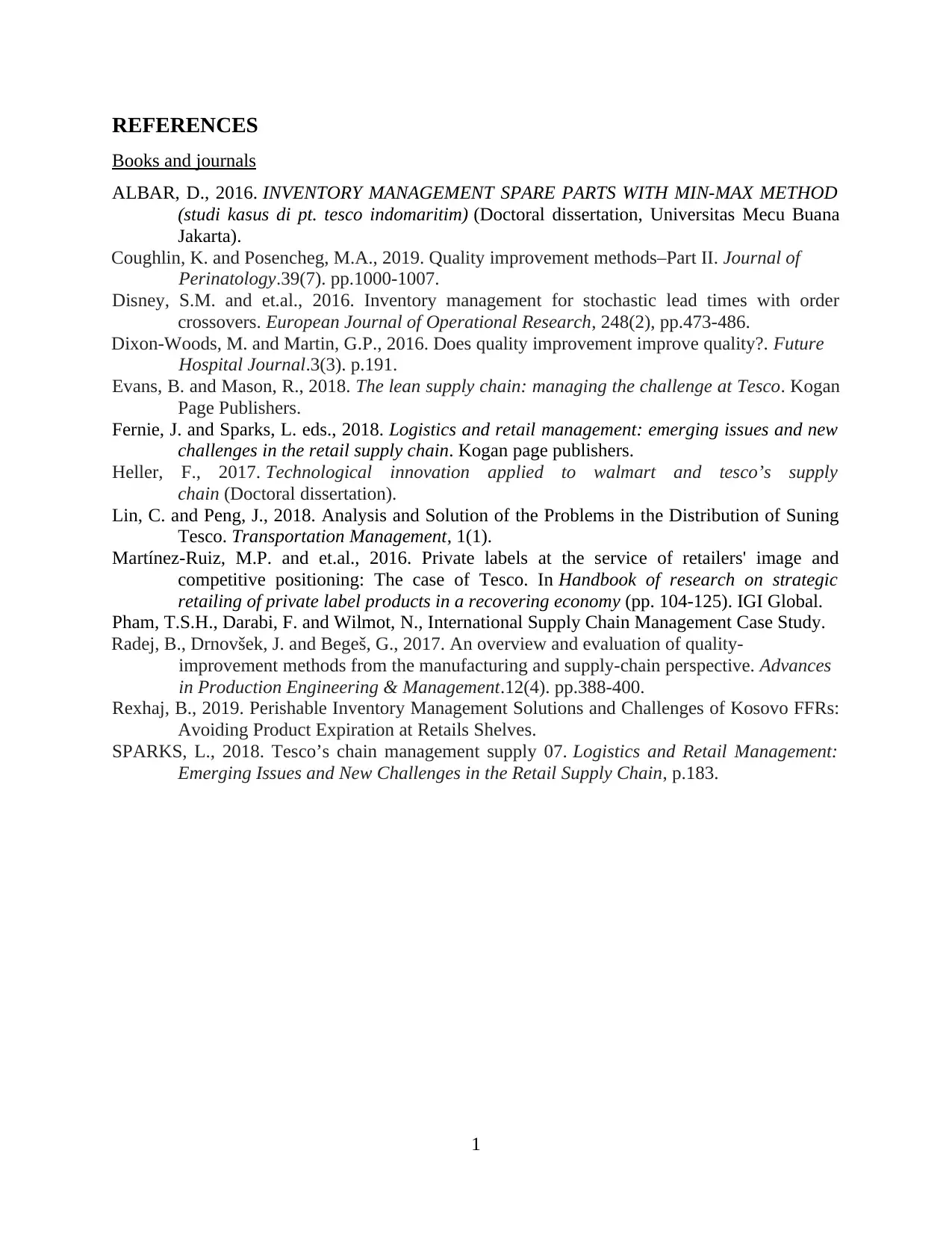
REFERENCES
Books and journals
ALBAR, D., 2016. INVENTORY MANAGEMENT SPARE PARTS WITH MIN-MAX METHOD
(studi kasus di pt. tesco indomaritim) (Doctoral dissertation, Universitas Mecu Buana
Jakarta).
Coughlin, K. and Posencheg, M.A., 2019. Quality improvement methods–Part II. Journal of
Perinatology.39(7). pp.1000-1007.
Disney, S.M. and et.al., 2016. Inventory management for stochastic lead times with order
crossovers. European Journal of Operational Research, 248(2), pp.473-486.
Dixon-Woods, M. and Martin, G.P., 2016. Does quality improvement improve quality?. Future
Hospital Journal.3(3). p.191.
Evans, B. and Mason, R., 2018. The lean supply chain: managing the challenge at Tesco. Kogan
Page Publishers.
Fernie, J. and Sparks, L. eds., 2018. Logistics and retail management: emerging issues and new
challenges in the retail supply chain. Kogan page publishers.
Heller, F., 2017. Technological innovation applied to walmart and tesco’s supply
chain (Doctoral dissertation).
Lin, C. and Peng, J., 2018. Analysis and Solution of the Problems in the Distribution of Suning
Tesco. Transportation Management, 1(1).
Martínez-Ruiz, M.P. and et.al., 2016. Private labels at the service of retailers' image and
competitive positioning: The case of Tesco. In Handbook of research on strategic
retailing of private label products in a recovering economy (pp. 104-125). IGI Global.
Pham, T.S.H., Darabi, F. and Wilmot, N., International Supply Chain Management Case Study.
Radej, B., Drnovšek, J. and Begeš, G., 2017. An overview and evaluation of quality-
improvement methods from the manufacturing and supply-chain perspective. Advances
in Production Engineering & Management.12(4). pp.388-400.
Rexhaj, B., 2019. Perishable Inventory Management Solutions and Challenges of Kosovo FFRs:
Avoiding Product Expiration at Retails Shelves.
SPARKS, L., 2018. Tesco’s chain management supply 07. Logistics and Retail Management:
Emerging Issues and New Challenges in the Retail Supply Chain, p.183.
1
Books and journals
ALBAR, D., 2016. INVENTORY MANAGEMENT SPARE PARTS WITH MIN-MAX METHOD
(studi kasus di pt. tesco indomaritim) (Doctoral dissertation, Universitas Mecu Buana
Jakarta).
Coughlin, K. and Posencheg, M.A., 2019. Quality improvement methods–Part II. Journal of
Perinatology.39(7). pp.1000-1007.
Disney, S.M. and et.al., 2016. Inventory management for stochastic lead times with order
crossovers. European Journal of Operational Research, 248(2), pp.473-486.
Dixon-Woods, M. and Martin, G.P., 2016. Does quality improvement improve quality?. Future
Hospital Journal.3(3). p.191.
Evans, B. and Mason, R., 2018. The lean supply chain: managing the challenge at Tesco. Kogan
Page Publishers.
Fernie, J. and Sparks, L. eds., 2018. Logistics and retail management: emerging issues and new
challenges in the retail supply chain. Kogan page publishers.
Heller, F., 2017. Technological innovation applied to walmart and tesco’s supply
chain (Doctoral dissertation).
Lin, C. and Peng, J., 2018. Analysis and Solution of the Problems in the Distribution of Suning
Tesco. Transportation Management, 1(1).
Martínez-Ruiz, M.P. and et.al., 2016. Private labels at the service of retailers' image and
competitive positioning: The case of Tesco. In Handbook of research on strategic
retailing of private label products in a recovering economy (pp. 104-125). IGI Global.
Pham, T.S.H., Darabi, F. and Wilmot, N., International Supply Chain Management Case Study.
Radej, B., Drnovšek, J. and Begeš, G., 2017. An overview and evaluation of quality-
improvement methods from the manufacturing and supply-chain perspective. Advances
in Production Engineering & Management.12(4). pp.388-400.
Rexhaj, B., 2019. Perishable Inventory Management Solutions and Challenges of Kosovo FFRs:
Avoiding Product Expiration at Retails Shelves.
SPARKS, L., 2018. Tesco’s chain management supply 07. Logistics and Retail Management:
Emerging Issues and New Challenges in the Retail Supply Chain, p.183.
1
Paraphrase This Document
Need a fresh take? Get an instant paraphrase of this document with our AI Paraphraser

2
1 out of 11
Related Documents
Your All-in-One AI-Powered Toolkit for Academic Success.
+13062052269
info@desklib.com
Available 24*7 on WhatsApp / Email
![[object Object]](/_next/static/media/star-bottom.7253800d.svg)
Unlock your academic potential
Copyright © 2020–2025 A2Z Services. All Rights Reserved. Developed and managed by ZUCOL.





